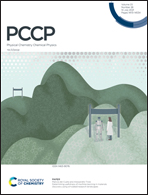Lead-free perovskite compounds CsSn1−xGexI3−yBry explored for superior visible-light absorption
Abstract
Hybrid perovskites are favoured over other numerous optoelectronic materials, thanks to their rapidly enhanced power conversion efficiency (PCE) and facile processing. At present, future developments are seriously hampered by the high toxicity of heavy metals and poor stability. Inorganic lead-free perovskites, CsSn1−xGexI3−yBry, are herein explored for superior optical performance by first-principles calculations based on density functional theory (DFT). It is unveiled that the valence band maximum (VBM) is mainly occupied by the p-orbit of halide ions, while the conduction band minimum (CBM) is composed of the p-orbit of the metal ion. Moreover, Bader charge analysis shows that CsSn0.5Ge0.5I3 corresponds to the most obvious charge transfer compared to the others. The defect formation energy indicates that perovskite compounds CsSn1−xGexI3−yBry, are more easily synthesized than the series CsSn1−xGexI3, and the physically accessible area is also determined in the coordinate system defined by the chemical potential change of the host atoms, ΔμSn and ΔμI. Additionally, the absorption spectra show that among the doped compounds of the form CsSn0.5Ge0.5I3−yBry, perovskite CsSn0.5Ge0.5I2Br is superior in terms of optical response in the visible-light range. The results shed a new light on the study of highly efficient and stable lead-free perovskite-based solar cells (PSCs).



 Please wait while we load your content...
Please wait while we load your content...